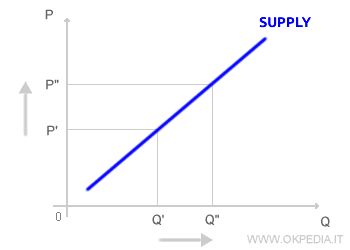Market Supply
Market supply represents the total quantity of a good made available by all participants (producers and sellers) in the market, based on its price. It is a fundamental component that, together with demand, drives how the market functions.
The Supply Function
Supply follows a straightforward principle: the more profitable a good is, the greater the effort businesses will invest to produce and offer it. However, this relationship is shaped by several factors that can influence suppliers' behavior:
- Price. Market supply is closely tied to the price of the good. As prices rise, the quantity supplied in the market tends to increase, and vice versa. Higher prices motivate producers to ramp up production, as this leads to greater revenue. On the other hand, falling prices may discourage production, leading to a reduced supply. For this reason, price is the primary driver of supply.

Why does supply increase with price? The positive relationship between supply and price is explained by the law of supply. This principle is grounded in the basic objective of businesses: to maximize profit. When the price of a good goes up, companies are more likely to allocate resources toward its production. For example, in the real estate market, rising house prices often encourage developers to build more homes to capitalize on higher profit opportunities.
- Number of Suppliers. The number of suppliers (producers or sellers) also impacts market supply. An increase in suppliers expands the total quantity of goods available at the same price, while a reduction in the number of producers has the opposite effect.

Example. Higher prices can attract new producers into the market. The entry of a new company adds to the total quantity supplied at the same price, increasing overall market supply. Conversely, falling prices may push smaller or less competitive firms out of the market, leading to a drop in supply. For instance, when a new car manufacturer enters the automotive industry, the supply of cars increases. However, if some companies exit the market due to financial struggles, the total car supply decreases.
Beyond these primary factors, several secondary but still significant factors also influence supply.
- Production Conditions. Factors such as production costs, the availability of raw materials, and technological advancements directly affect a company's ability to scale supply up or down.
Example. The introduction of innovative farming technologies can lower production costs, enabling an increase in supply without altering the selling price.
- External Influences. Government policies, such as subsidies or taxes, along with climatic or geopolitical factors, can have a significant impact on supply. For instance, a production subsidy might encourage increased output, while new taxes could discourage it.
Market Supply vs. Individual Supply
Market supply is the total of all individual supplies, which reflect the quantities offered by each economic player. While individual supply focuses on the relationship between price and quantity offered by a single entity, market supply encompasses the collective contributions of all firms within a specific industry.
Example. A single baker might decide to bake more bread if prices rise, but the total supply of bread in a city depends on the combined decisions of all bakers.
Supply Elasticity
Elasticity measures how responsive supply is to changes in price. If a good has elastic supply, even a small price change can lead to a significant shift in the quantity supplied. Conversely, inelastic supply indicates that quantity changes only marginally in response to price fluctuations.
Example. Agricultural products often have inelastic supply in the short term due to the time required for production cycles.
In summary, market supply is one of the two critical forces shaping economic equilibrium, particularly within the context of market dynamics.
